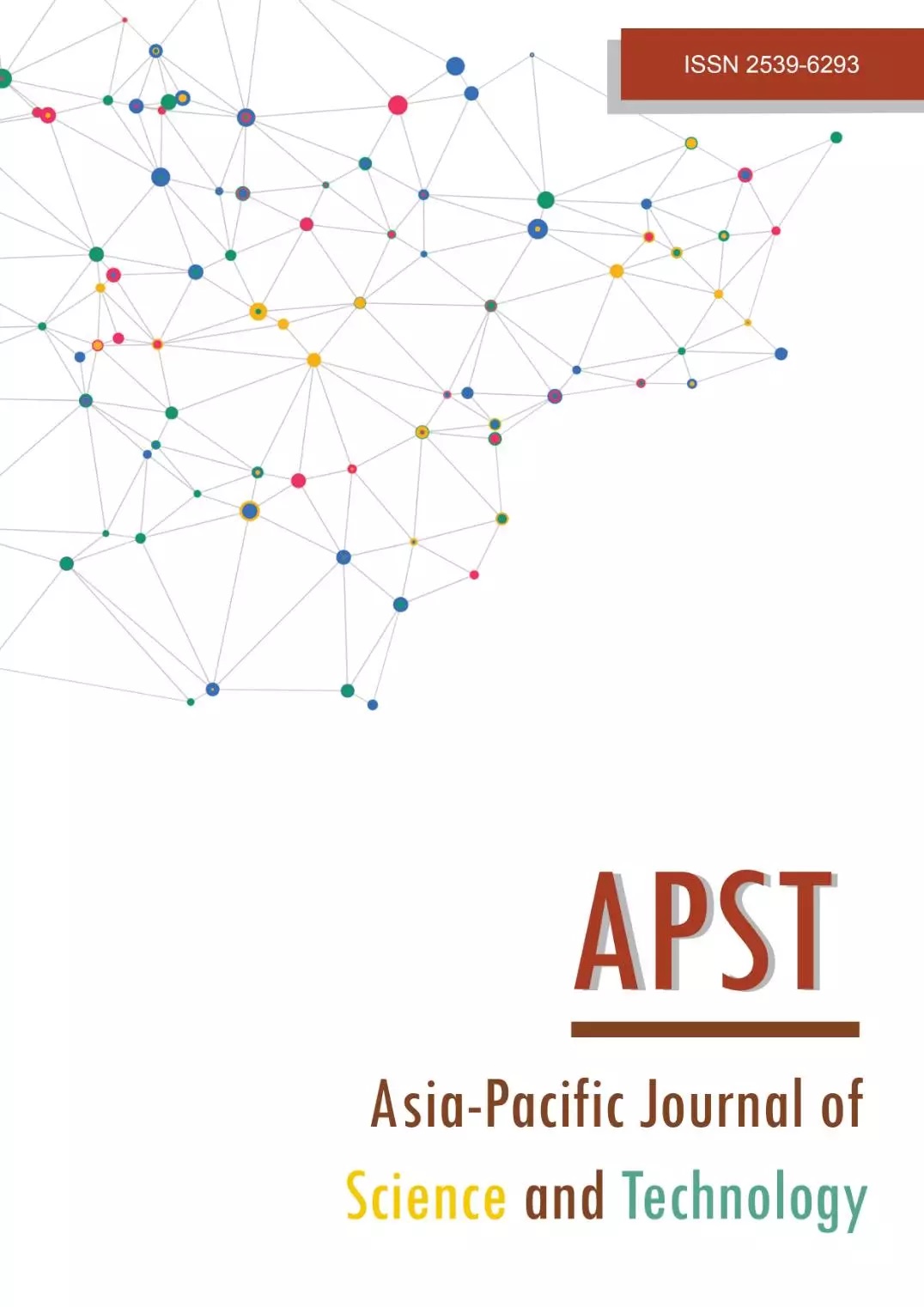Effect of heating conditions on physical and chemical characteristics of sugar syrup
Main Article Content
Abstract
There has been an interest in the development of Thai local products, including palm sugar. The main raw material of palm sugar in Thailand is the sap of Palmyra palm. The heating process to produce sugar syrup leads to physical and chemical changes. A limitation of 5-hydroxymethyl furfural (HMF) content has been set according to the regulation by Codex Alimentarius (CA) due to its carcinogenic potency. The degree of physical and chemical changes depends on the heating rate and time. It is important to study the effect of slow and quick heating rate for syrup production. Palmyra palm sap had the L*, a*, b* values of 69.21, -0.21 and 8.17. The total and reducing sugar contents were 10.10% and 0.89%, respectively. This sap contained 227.13 mg/L GAE of phenolic compounds and exhibited 0.28 μmol TE/g sample of antioxidant activity. The sap with initial soluble solids of 12.40°Brix was then heated with small flame (slow heating) and big flame (quick heating) to obtain the syrup with the minimum soluble solids of 65°Brix. The slow-heated syrup exhibited significantly higher antioxidant activity and phenolic compounds in comparison to quick-heated syrup (p<0.05). Quick heated syrup had lighter color, while slow heating produced dark, reddish brown color (p<0.05). Quick-heated syrup (HMF 17.54 mg/kg) was in agreement with CA (<80.00 mg/kg). However, the slow-heated syrup exceeded the maximum standard (HMF 56.34 mg/L). Quick heating is suggested over slow heating for Palmyra palm syrup production to prevent the HMF content from exceeding the CA recommendation during storage.
Article Details
References
Chaurasiya AK, Chakraborty I, Saha J. Value addition of palmyra palm and studies on the storage life. J Food Sci Technol. 2014;51(4):768-773.
Tamunaidu P, Saka S. Chemical characterization of various parts of nipa palm (Nypa fruticans). Ind Crops Prod. 2011;34(3):1423-1428.
Tsuji K, Sebastian LS, Ghazalli MNF, Dulloo ME. Biological and ethnobotanical characteristics of nipa palm (Nypa fructicans Wurmb): a review. Sains Malays. 2011;40(12):1407-1412.
Phaichamnan M, Posri W, Meenune M. Quality profile of palm sugar concentrate produced in Songkhla province, Thailand. Int Food Res J. 2010;17(2):425-432.
Srikaeo K, Sangkhiaw J, Likittrakulwong W. Productions and functional properties of palm sugars. Walailak J Sci & Tech. 2019;16(11):897-907.
Thai Industrial Standard Ministry [Internet]. Bangkok: Ministry of Industry; 2015. [cited 2019 May 15]. Community product standards 113/2018. Available from: http://tcps.tisi.go.th/public/StandardList.aspx.
Ho CW, Aida WM, Maskat MY, Osman H. Effect of thermal processing of palm sap on the physicochemical composition of traditional palm sugar. Pak J Biol Sci. 2008;11(7):989-995.
Naknean P, Meenune M, Roudaut G. Changes in physical and chemical properties during the production of palm sugar syrup by open pan and vacuum evaporator. As J Food Ag-Ind. 2009;2(4):448-456.
Apriyantono AA. Aristyani Y. Nurhayati S. Lidya B, Soekarto ST. Rate of browning reaction during preparation of coconut and palm sugar. Int Congr Ser. 2002;1245:275-278.
Zhou Y, Li Y, Lu Y. The effects of reactants ratios, reaction temperatures and times on Maillard reaction products of the L-ascorbic acid/L-glutamic acid system. Food Sci Technol (Campinas) 2016;36(2):268-274.
Severin I, Dumont C, Cabaton JA, Graillot V, Chagnon MC. Genotoxic activities of the food contaminant 5-hydroxymethylfurfural using different in vitro bioassays. Toxicol Lett. 2010;192(2):189-194.
R. Kell, editor. Codex stand 12-1981 rev.1 [Internet]. Rome: FAO;1996 [cited 2019 May 15]; Available from: http://www.fao.org/3/w0076e/w0076e30.htm.
Shapla UM, Solayman M, Alam N, Khalil MI, Gan SH. 5-hydroxymethylfurfural (HMF) levels in honey and other food products: effects on bees and human health. Chem Cent J. 2018;12(35):1-18.
National Standardization Agency of Indonesia [Internet]. Jakarta: National Standardization Body; c2021 [cited 2019 May 15]. National Standard of Indonesia for syrup SNI 01-3544-1994. Available from: http://sispk.bsn.go.id/SNI/DetailSNI/3924.
Naknean P. Factors affecting browning and crystallisation of palm sugar syrup and palm sugar cake. Chem. 2010;4:203.
Pontoh J. The role of analytical chemistry in the development of quality criteria for palm sugar. In: Kramadibrata K, editor. The Indonesian National Seminar of Applied Chemistry; 2013 May 23; Solo, Indonesia. Jarkata: LIPI Press; 2013. p. 1-8.
Naknean P, Meenune M. Characteristics and antioxidant activity of palm sugar syrup produced in Songkhla province, southern Thailand. As J Food Ag-Ind. 2011;4(4):204-212.
Horwitz W, Latimer G, editors. Official methods of analysis of AOAC international. 18th ed. Washington, DC: AOAC International; 2010.
Lahsasni S, Kouhila M, Mahrouz M, Mohamed LA, Agorram B. Characteristic drying curve and mathematical modeling of thin-layer solar drying of prickly pear cladode (Upuntia ficus indica). J Food Process Eng. 2014;27(2):103-107.
Quintas MA, Brandao TR, Silva CL. Modelling colour changes during the caramelisation reaction. J Food Eng. 2007;83(4):483-491.
Mlotkiewicz JA. The role of the Maillard reaction in the food industry. In: O’Brien J, Nursten HE, Crabbe JC, Ames JM, editors. The 6th International Symposium on the Maillard Reaction;1997 Jul 27-30; London, UK. Cambridge:Woodhead Publishing Limited;1998. p. 19-27.
Kroh LW. Caramelisation in food and beverages. Food Chem. 1994;51(4):373-379.
Damodaran S, Parkin K. Fennema’s Food Chemistry. 5th ed. Florida; CRC Press; 2017.


